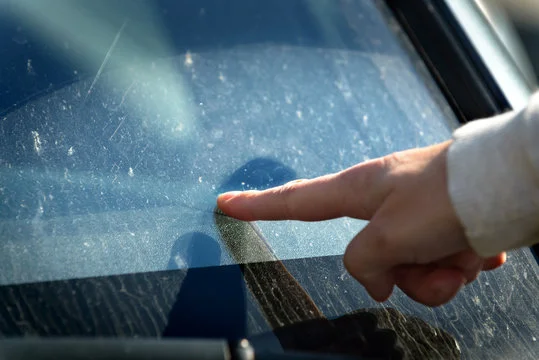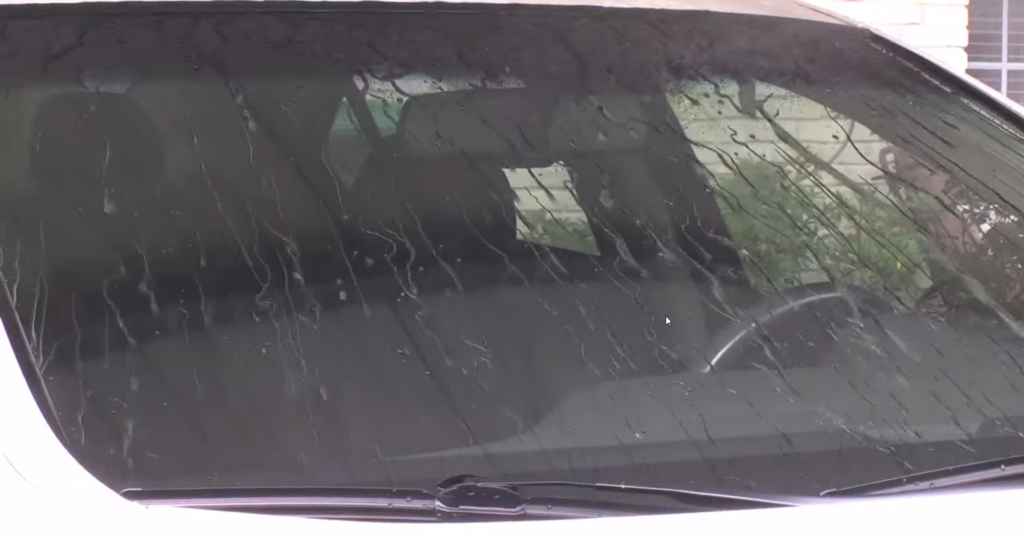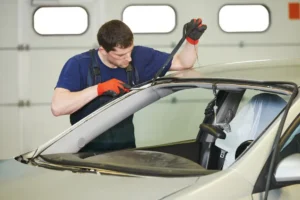Ford F150 Rear Window Replacement Ford F150 rear window replacement is essential for maintaining the...
Understanding and Eliminating Water Stains on Windshields| A Comprehensive Guide
Water stains on windshields refer to the unsightly marks and residue left behind by water droplets drying on the glass surface. These stains can vary in severity, from minor spots to more noticeable streaks, and are often caused by a combination of mineral deposits, dirt, and other impurities present in the water. Addressing water stains is important not only for aesthetic reasons but also for maintaining visibility and ensuring safe driving conditions.
Understanding Water Stains On Windshield

Definition of Hard Water Stains on Windshield:
Hard water stains on windshields refer to mineral deposits left behind when water containing high levels of minerals such as calcium and magnesium evaporates. These stains can appear as white spots or streaks on the glass surface and can be challenging to remove.
Different Types of Water Stains:
Hard Water Stains: These stains are caused by the presence of minerals in water and appear as white spots or streaks on the windshield.
Mineral Deposits: Similar to hard water stains, mineral deposits occur when water containing minerals evaporates, leaving behind deposits on the glass surface.
Acid Rain Marks: Acid rain contains pollutants like sulfur dioxide and nitrogen oxides, which can etch the glass surface, leaving marks or spots that are difficult to remove.
Environmental Residues: Various environmental factors such as pollution, pollen, tree sap, and bird droppings can leave residues on windshields, which may require specific cleaning methods.
Causes of Water Stains on Windshield:
Hard Water: Water with high mineral content, commonly found in areas with limestone or chalk deposits, can leave behind hard water stains.
Environmental Factors: Acid rain, pollution, tree sap, bird droppings, and pollen can contribute to the formation of stains on windshields.
Irrigation Systems: Water from sprinkler systems or irrigation can contain minerals and chemicals that may leave stains when they come into contact with the windshield.
Washing Products: Some car washing products may leave residues or streaks on the windshield if not rinsed off properly, leading to the formation of stains over time.
Weathering: Exposure to harsh weather conditions such as extreme heat or cold can also contribute to the accumulation of stains on the windshield over time.
Types of Water Stains That Occur on Windshields

Hard Water Stains
Characteristics:
- Hard water stains are caused by minerals like calcium and magnesium present in water.
- They form when water droplets containing these minerals evaporate, leaving behind deposits on the windshield.
Appearance:
- Hard water stains typically appear as white or cloudy spots on the windshield’s surface.
- They can sometimes be difficult to remove and may appear crusty or gritty.
Formation Process:
- Hard water stains develop when water containing minerals evaporates from the windshield, leaving behind mineral deposits that adhere to the glass surface over time.
Mineral Deposits
Description:
- Mineral deposits consist of various minerals dissolved in water, such as calcium, magnesium, and silica.
- These deposits can accumulate on windshields through repeated exposure to water sources containing high mineral content.
Sources:
- Mineral deposits can originate from sources such as tap water, well water, or even rainwater that has absorbed minerals from the environment.
Impact on Windshield:
- Mineral deposits can create hazy or foggy spots on the windshield, reducing visibility.
- If left untreated, mineral deposits can etch into the glass surface, causing permanent damage.
Acid Rain Marks
Causes:
- Acid rain occurs when pollutants in the atmosphere, such as sulfur dioxide and nitrogen oxides, react with water vapor to form acidic compounds.
- When acid rain falls onto the windshield, it can leave behind visible marks due to its corrosive nature.
Visual Effects:
- Acid rain marks may appear as streaks or blotches on the windshield.
- They can vary in severity depending on the concentration of pollutants in the rain and the duration of exposure.
Potential Risks:
- Acid rain marks can gradually corrode the glass surface if not promptly removed, leading to pitting or weakening of the windshield over time.
- Reduced visibility caused by acid rain marks can pose safety hazards while driving.
Environmental Residues
Overview:
- Environmental residues refer to contaminants deposited on the windshield from sources such as tree sap, pollen, bird droppings, or industrial pollutants.
- These residues can accumulate and adhere to the glass surface, affecting visibility and aesthetics.
Common Sources:
- Tree sap, pollen, and bird droppings are common sources of environmental residues.
- Industrial pollutants from factories or vehicles can also contribute to the accumulation of residues on windshields.
Prevention Strategies:
- Regularly cleaning the windshield with a gentle cleanser and water can help prevent the buildup of environmental residues.
- Parking in covered areas or using a windshield cover can provide protection against exposure to environmental contaminants. If you want professional guidance then Reliable Auto Glass is best in business.
How to Get Rid of Water Stains on Windshield
To effectively remove water stains from your windshield, you can employ various methods ranging from basic cleaning techniques to specialized approaches for hard water stains. Additionally, implementing preventive measures can help avoid the recurrence of water stains. Here’s a comprehensive guide:
Basic Cleaning Methods:
Soap and Water:
- Mix mild dish soap with warm water in a bucket.
- Use a sponge or microfiber cloth to apply the solution to the windshield.
- Scrub gently in circular motions to loosen the water stains.
- Rinse thoroughly with clean water and dry with a lint-free cloth.
Vinegar Solution:
- Mix equal parts of white vinegar and water in a spray bottle.
- Spray the solution onto the stained areas of the windshield.
- Let it sit for a few minutes to dissolve the stains.
- Wipe the windshield with a clean cloth or paper towels.
- Rinse with water and dry to remove any remaining residue.
Commercial Glass Cleaners:
- Choose a glass cleaner specifically formulated to remove water stains.
- Follow the instructions on the product label for the best results.
- Spray the cleaner onto the windshield and wipe with a clean cloth or paper towels.
- Repeat if necessary until the stains are fully removed.
Specialized Techniques for Hard Water Stains:
Lemon Juice and Baking Soda Solution:
- Create a paste by mixing lemon juice and baking soda until it forms a thick consistency.
- Apply the paste to the water stains using a soft cloth or sponge.
- Let it sit for a few minutes to penetrate the stains.
- Scrub gently in circular motions, focusing on the affected areas.
- Rinse with water and dry thoroughly.
Glass Polishing Compounds:
- Choose a glass polishing compound designed for removing water stains.
- Apply a small amount of the compound onto a clean, dry microfiber cloth.
- Rub the compound onto the stained areas using firm pressure.
- Continue rubbing until the stains are visibly diminished or removed.
- Wipe off any excess compound with a clean cloth and buff the windshield to a shine.
Clay Bar Treatment:
- Purchase a clay bar kit designed for automotive use.
- Follow the instructions provided with the kit to knead the clay bar and prepare it for use.
- Spray a lubricant or detailing spray onto the windshield.
- Gently rub the clay bar over the stained areas, applying light pressure.
- Continue until the stains are lifted and the surface feels smooth.
- Wipe off any residue with a clean cloth.
Preventive Measures:
Regular Cleaning and Maintenance:
- Clean your windshield regularly to prevent water stains from accumulating.
- Use a squeegee to remove excess water after washing your car or driving in the rain.
- Address any spills or splatters promptly to prevent them from drying onto the windshield.
Protective Coatings:
- Apply a hydrophobic windshield coating to repel water and prevent stains.
- Follow the manufacturer’s instructions for proper application and reapplication intervals.
Parking Considerations:
- Avoid parking your car under trees or near sources of water that can cause mineral deposits to accumulate on the windshield.
- If possible, park in a covered garage to protect your windshield from the elements.
Conclusion
In conclusion, addressing water stains on windshields is crucial for maintaining visibility and safety while driving. These stains can significantly impair vision, especially during adverse weather conditions. By regularly removing water stains, drivers can ensure a clear and unobstructed view of the road ahead, reducing the risk of accidents. Feel free to contact us for any type of services or query like water stains on windshield.
FAQs
What Causes Water Stains On Windshields?
Water stains on windshields can be caused by various factors including hard water deposits, minerals in the water, dirt and debris, environmental pollutants, and even residue from car care products.
How Do I Prevent Water Stains On My Windshield?
Regularly cleaning your windshield with a mild detergent and water can help prevent water stains. Additionally, using a water repellent product specifically designed for windshields can create a protective barrier, reducing the likelihood of water stains forming.
Can Water Stains Affect Visibility While Driving?
Yes, water stains can affect visibility by creating streaks and spots on the windshield, especially when exposed to sunlight or headlights at night. Over time, these stains can worsen and impair visibility, potentially compromising safety on the road.
How Do I Remove Water Stains From My Windshield?
Several methods can be used to remove water stains from windshields, including using vinegar or lemon juice mixed with water, rubbing alcohol, or specialized glass cleaners. It’s important to use a soft cloth or sponge to avoid scratching the glass surface.
Are There Commercial Products Available For Removing Water Stains?
Yes, there are many commercial products specifically formulated to remove water stains from windshields. These products often contain mild acids or abrasives that effectively break down and remove stubborn stains. Always follow the manufacturer’s instructions when using these products.
Can I Prevent Water Stains By Using Distilled Water In My Windshield Washer Fluid?
Using distilled water in your windshield washer fluid can help reduce the likelihood of water stains, as it lacks the minerals found in tap water that contribute to staining. However, it may not completely eliminate the problem, especially if other factors like environmental pollutants are present.
Our Services
Our Latest Blogs
Affordable Kia Soul Window Replacement Services
Affordable Kia Soul Window Replacement Services Kia Soul window replacement is a necessary procedure that...
Professional Kia Window Replacement | Trusted Experts
Professional Kia Window Replacement | Trusted Experts Kia window replacement is crucial for maintaining the...
Hyundai Windshield Replacement Made Easy | Trusted Services
Hyundai Windshield Replacement Hyundai windshield replacement services are crucial for maintaining the integrity and safety...





